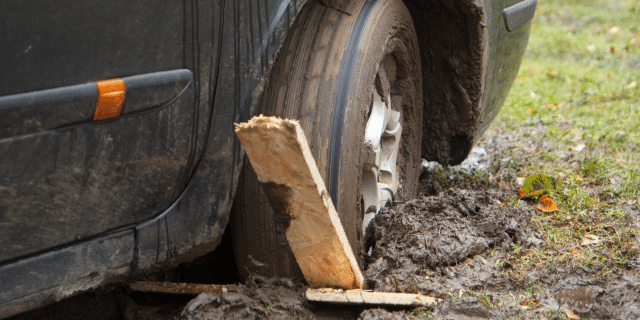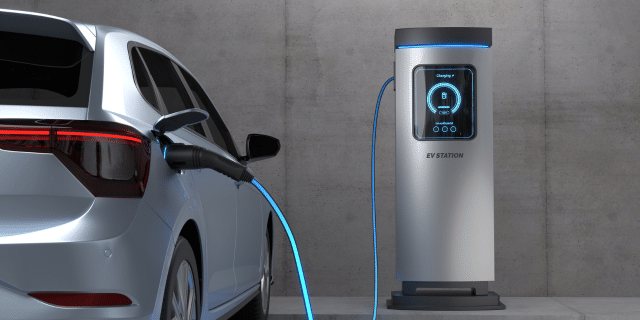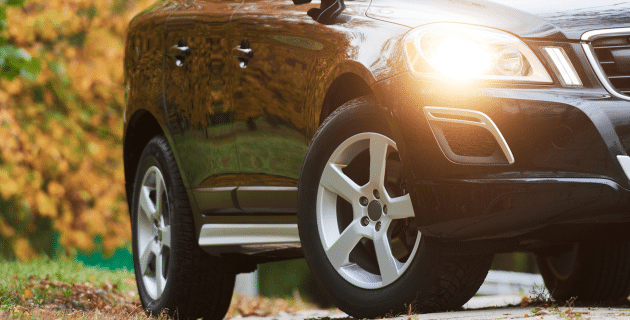
by California Casualty | Auto Insurance Info |
Stuck in the mud? Whether you veered off the beaten path or got caught in an unexpected downpour, finding your car’s tires spinning in place can be frustrating. But don’t hit the panic button just yet—getting unstuck is easier than you may think. Before you call for a tow, try these techniques to free your vehicle and get back on solid ground.
Why Vehicles Get Stuck in Mud
There are a few common reasons why your car might end up trapped in the mud:
- The ground is too soft or wet. After heavy rain or in naturally muddy areas, the ground may not provide enough support for your vehicle’s weight.
- Your tires don’t have enough tread. Worn-out tires struggle to grip the surface, making it easier to get stuck.
- You over-revved the engine. Spinning the wheels too aggressively can dig them deeper into the mud instead of propelling the car forward.
Different Types of Mud and Their Challenges
Not all mud is the same. Different types of mud can affect a vehicle differently:
- Clay-heavy mud: This mud is extremely sticky and can cake onto tires, reducing grip.
- Sandy or silty mud: This type of mud drains water faster but can create deep ruts.
- Deep standing water with mud: This mud can flood engine components, making escape trickier.
Steps to Get Your Vehicle Free
1. Stay Calm and Assess the Situation
The first thing to do is stay calm. You’ve got this. The first step is to see if you’re able to take care of the problem, or if you need to call for help. If it’s safe to do so, step out of the vehicle and check how deep your tires are stuck. This will help you determine the best method to get unstuck.
2. Clear the Mud Around Your Tires.
Do you carry a shovel in your car? If not, you might want to add one to your car emergency kit. If you have access to a shovel or trowel, use it to dig the mud away from your tires as much as possible. If not, move on to the next step.
3. Create Traction Under Your Tires
Your tires need something solid to grip. You want to give them some traction. Look around and see what you have that might be able to do so.
- Place floor mats, car carpets, sand, gravel, towels, or non-clay kitty litter under your tires. (You can also keep some of this in your car safety kit for future emergencies.)
- You can even try rocks, twigs, or branches if available.
- Position the traction aids in front or behind the tires, in the direction you’re trying to move.
4. Adjust Your Steering Angle
It could be that your tires are in a rut. By turning your steering wheel slightly, it can allow your tires to find a fresh patch of ground with better traction. Do that as a next step, before you apply the gas.
5. Gently Accelerate
You may be anxious to get out of there but don’t press too hard on the gas pedal. That can make the situation worse by causing the wheels to spin. Apply slow, steady pressure to see if your tires can gain traction.
6. Try the Rocking Method
If your car is still stuck, gently shift between drive and reverse to create momentum. This rocking motion can help you inch your way out. Try it a few times but stop if it’s not working so you won’t cause damage to the transmission.
- If your vehicle has winter mode, a differential lock or four-wheel drive, engage it for extra power.
- If you have a manual transmission, start it in second gear to reduce wheel spin.
- If you drive a rear-wheel drive car, shift some weight to the back (such as moving heavy items to the trunk) for better traction.
7. Consider Deflating Your Tires
Letting out a small amount of air increases the tire’s surface area, improving grip. Be careful not to over-deflate—aim to maintain at least 20 PSI to avoid driving on dangerously low tires once you’re out. Make sure to reinflate as soon as possible.
8. Call for Help If Needed
If none of these methods work, it’s time to call in the professionals. A tow truck can safely get your car out. Once your vehicle is free from the mud, inspect it for any damage. Check the tires especially for cuts or bulges. Get your car washed and consider a vehicle checkup if you are concerned.
Prevent Future Mud Problems
It’s not always possible to avoid an emergency like getting stuck in the mud, but these tips can help.
- Drive carefully. Navigate muddy roads with caution and avoid areas that could have deep mud, especially during heavy rains.
- Maintain your vehicle. Check your tires to make sure they have good tread. Replace them as needed.
- Carry essential tools. Keep a shovel, floor mats and other essentials in your car for emergencies.
Finally, protect your vehicle with the right insurance for added peace of mind.
This article is furnished by California Casualty, providing auto and home insurance to educators, law enforcement officers, firefighters, and nurses. Get a quote at 1.866.704.8614 or www.calcas.com.

by California Casualty | Auto Insurance Info |
Thinking about going green with your next vehicle? Hybrid and electric cars both offer fuel savings and eco-friendly benefits, but which one is the better fit for your lifestyle? From driving range to charging convenience—and even how they handle in different weather conditions—we’ll break down the pros and cons to help you decide.
What’s the difference?
- Hybrid Vehicle: A hybrid car has a gasoline engine and an electric motor. The gas engine and battery-powered motor work together to improve fuel efficiency and reduce emissions. Hybrids don’t need to be plugged in because they recharge the battery while you drive.
- Electric Vehicle (EV): An EV runs entirely on electricity. It has no gas engine—just a battery and an electric motor. EVs need to be plugged in to charge, and they produce zero emissions, making them an eco-friendly choice.
Pros and Cons
Let’s take a deeper dive and explore the pros and cons of each, including how they fare in extreme weather.
Hybrid Vehicles
Pros
- Better Fuel Efficiency – Hybrids use less gas than traditional cars, saving money at the pump.
- No Charging Required – The battery recharges while you drive, so there’s no need to plug it in.
- Smoother, Quieter Ride – The electric motor helps reduce engine noise and provides a seamless driving experience.
- Longer Driving Range – Since hybrids use both gas and electricity, you won’t have range anxiety like with some EVs.
In Extreme Weather…
- Quick Warmup – A hybrid may be safely driven with only a short warmup—about a minute in cold weather.
- Less Affected by Cold Weather – Since hybrids have a gas engine, they don’t rely solely on battery power, which helps maintain performance in freezing temperatures.
- No Need for Charging – Unlike EVs, hybrids don’t depend on charging stations, which can be slower or less available in extreme conditions.
- Consistent Range – Cold or hot weather has less impact on a hybrid’s driving range compared to a fully electric vehicle.
Cons
- Less Fuel Savings Than an EV – Hybrids still rely on gas, so it’s not as cost-effective as a fully electric vehicle in the long run.
- More Maintenance Than an EV – Since hybrids have both an engine and a battery system, they require more maintenance than an all-electric car.
- Battery Replacement Costs – The hybrid battery can be expensive to replace, though it usually lasts many years.
In Extreme Weather…
- Reduced Fuel Efficiency in Cold – The gas engine runs more often in low temperatures, slightly lowering fuel economy.
- Battery Performance Can Drop – While not as noticeable as in EVs, extreme cold can still reduce battery efficiency.
- Hot Weather Can Strain the System – High temperatures may cause the battery and engine to work harder, potentially leading to wear over time.
Electric Vehicles
Pros
- Zero Emissions – EVs don’t burn gas, making them the most eco-friendly option.
- Lower Operating Costs – Charging is often cheaper than fueling up, and there’s no need for oil changes or many traditional maintenance
- Quiet and Smooth Ride – Electric motors make EVs nearly silent and provide instant acceleration.
- Fewer Moving Parts – Less wear and tear means fewer repairs compared to gas or hybrid cars.
- Incentives and Tax Credits – Many EV buyers qualify for government rebates and incentives, reducing the purchase cost.
In Extreme Weather…
- Instant Start – EVs don’t have traditional engines that require oil or warming up, so they start instantly, even in freezing temperatures.
- More Efficient in Stop-and-Go Traffic – Unlike gas-powered cars, EVs don’t waste energy idling, making them efficient in winter traffic jams.
- Preconditioning Helps – Many EVs allow you to warm up or cool down the car while plugged in, reducing the impact on battery life.
Cons
- Higher Upfront Cost – EVs can be more expensive than gas or hybrid cars, though prices are improving.
- Limited Range – Some EVs can’t travel as far on a single charge as a gas or hybrid car can on a full tank.
- Charging Time – Even fast charging takes longer than a quick stop at a gas station.
- Charging Infrastructure – Public charging stations aren’t as common as gas stations, and home charging requires special installation.
- Crash-related fires – Should a crash occur, and damage the battery, it could spark a fire. EV fires are much harder to control than those of gas-powered vehicles.
In Extreme Weather…
- Cabin heat – It takes a lot of battery to warm the cabin. It’s better to warm the cabin while the car is still plugged in for about 5-10 minutes. Otherwise, you’ll reduce your driving range significantly.
- More HVAC Impact – Heating and cooling the cabin draws power from the battery, further reducing range.
- Reduced Range in Cold Weather – EVs can lose 10–36% of their range in freezing temperatures because the battery works harder.
- Slower Charging in the Cold – Charging times increase in low temperatures, making it less convenient for road trips.
- Hot Weather Can Overheat Batteries – High heat can degrade battery life over time and make charging less efficient.
Both hybrids and EVs typically cost more to repair than gas-powered cars due to specialized parts and technology (like battery systems). This can lead to higher insurance premiums. Talk to your insurer about a policy that’s right for your budget and needs.
This article is furnished by California Casualty, providing auto and home insurance to educators, law enforcement officers, firefighters, and nurses. Get a quote at 1.866.704.8614 or www.calcas.com.

by California Casualty | Auto Insurance Info, Helpful Tips |
Your car is more than just a mode of transportation; it’s a companion on life’s journey. But like any good friend, it needs a little care to keep it going strong. Whether you’re a road trip enthusiast or someone who relies on their wheels for daily commutes, extending the life of your vehicle makes sense. So, buckle up as we explore some simple yet effective ways to make your car last longer.
Ditch the heavy keychain.
When you put the key into the ignition, a heavy keychain can drag it down. That puts pressure on the tumblers inside the ignition. Over time, that can cause the ignition switch to fail. If your car keys share space with lots of other keys, consider a car-only keychain.
Watch for this warning sign: your key sticking in the ignition when you turn on the car. Get the ignition replaced before it leaves you stranded.
Use your parking brake.
The parking brake has an important job: to keep your car from rolling when parked. However, you don’t just need a parking brake on an incline; you need it whenever and wherever you park. Parking brakes help take the stress off the transmission. In addition, if not used, your parking brake can corrode over time. This can lead to expensive repairs. So, engage that parking brake whenever you park.
Don’t idle in the driveway.
It’s not a good idea to idle your car for long periods of time. Not only does it waste gas, but it can also do some damage. During idling, the oil pressure may not send oil to every part of the engine. The engine also won’t operate at its peak temperature. That means there could be incomplete fuel combustion, soot deposits on cylinder walls, contaminated oil, and damaged components.
Be mindful of moisture.
Moisture can do a lot of damage to your vehicle. Water that seeps into your car’s body panels can cause rust. Extreme heat and humidity can reduce your car’s battery life. Moisture inside your car can also lead to mold and mildew. Finally, salt water can damage your car’s paint. Don’t drive through water, which can expose your undercarriage to unnecessary moisture. Clean corroded battery terminals if you live in humid areas. Make sure to keep your car dry and as cool as possible during the hot, humid months to avoid expensive future repairs.
Change the oil and the air filter.
If your oil is dirty, it can affect the components in your engine. Without proper oil changes, your engine could seize up, which will cost you more than nearly any other car repair. Most manufacturers suggest changing the oil every 5,000-7,500 miles. Newer vehicles will alert you when you need an oil change. You also need to change the air filter, although not as often as the oil. The air filter removes dirt and debris, which also can harm your engine. Change your air filter every 15,000 to 20,000 miles.
Help your tires wear evenly.
Tires naturally wear down over time. Keep them working well by inflating them at the recommended pressure. That will help prevent blowouts. Tires also wear unevenly; that’s why it’s important to rotate them every 6 months or 6,000-8,000 miles. Otherwise, your tires will wear out faster and have to be replaced.
Wash your car.
Cars get dirty, and that dirt buildup is more than cosmetic. It can slowly destroy your paint, which can lead to rust. That’s why washing your car is important. How often depends on the weather, whether you park outside, and if your car is exposed to pollen, bugs, sap from trees, salt on winter roads and more. Wash biweekly or as needed and wax every month or so.
Prevent pests.
If you leave food and wrappers in your car, you could attract mice and bugs. They in turn can do damage that requires repairs. Clean up all food items, wrappers, and containers. Block broken seals or holes where they can get in. If you suspect pests, have your upholstery professionally cleaned.
Protect the interior.
Leather can become dry and brittle after years of exposure to the sun. Apply a conditioning solution routinely to help prevent cracks and keep seats in good condition. Use a windshield shade to help slow upholstery fading.
Don’t fill your tank if you see the tanker.
Gasoline tankers can stir up sediment as they refuel the tanks at gas stations. That could cause you to get dirty gasoline, which can clog your fuel filter or fuel injector. Avoid filling up at a station when it is being filled by a tanker. You’ll avoid a potential expensive repair.
Avoid bad driving habits.
Certain driving habits can reduce the lifespan of your car. Don’t brake hard all the time, it can lead to deterioration of your brake pads. Don’t turn at high speeds; that’s hard on your tires. Don’t strongly accelerate when the engine is cold. Don’t rev your engine when your car isn’t properly warmed up. Avoid potholes and running over curbs which can harm your tires. Good driving habits can help reduce the need for expensive repairs.
Pay attention to maintenance lights.
Don’t skip routine maintenance. It may cost you now but save you money in the long run.
If you have a newer car, it will let you know when it needs service. When the maintenance light is on, schedule your appointment. However, you can look out for things, too. If you hear an unusual noise, take your car in. Watch for puddles under your car. It’s better to get ahead of potential problems than to pay for them as they become big issues.
Keep your car protected.
You may do everything right but accidents still happen, including some that could total your car. Your car is one of your greatest investments. Protect it with the right auto insurance for added peace of mind.
Check out our blog on Pro Tips to Keeping Your New Car Ageless for more tips.
This article is furnished by California Casualty, providing auto and home insurance to educators, law enforcement officers, firefighters, and nurses. Get a quote at 1.866.704.8614 or www.calcas.com.

by California Casualty | Auto Insurance Info, Firefighters, Nurses, Peace Officers |
The winter season is a season of joy, celebration, and togetherness for many of us. For first responders — police, firefighters, nurses, paramedics – this time of year looks very different.
Winter is the time when emergencies increase. Icy conditions cause accidents. There are more heart attacks in cold temperatures. House fires are more common. Thefts are too. All of this keeps first responders working hard, and often extra hours. That means they sacrifice time with their own families to keep us safe.
Here are some thoughtful ways to show appreciation to our local heroes this holiday season and throughout the year. Remember, the key is to express genuine gratitude and to make these gestures personal and heartfelt.
Deliver some holiday cheer.
Make or buy some food or treats. Drop off coffee for the morning shift. Include donuts or pastries. A soft pretzel or cookie tray is always fun, and a homemade hot meal goes a long way. You also can drop off gift cards to local restaurants. Include cash to cover delivery fees and tips.
Bring a basket.
It’s cold out there. Put together an appreciation basket that includes the things that will make life easier for first responders doing their jobs this winter. Consider hand warmers, ChapStick, hand lotion, cough drops or hard candy, tissue packs, hot cocoa packets, and tea bags. Discover some more ideas in our blog on a winter survival kit.
Send notes and pictures.
Encourage your family and friends, especially children, to create handmade thank-you cards expressing appreciation for the hard work of first responders. Collect these cards and deliver them to the local police station, fire department, or hospital. Don’t forget that a personal handwritten note by anyone of any age is always appreciated.
Share your gratitude.
Write a letter to your local newspaper, sharing a positive story about the service provided by first responders in your community. Use social media platforms to thank your local first responders. Your positive stories can inspire others to express their gratitude as well.
Host a community appreciation event.
Coordinate a community gathering or event to express gratitude. This could be a small ceremony, a casual get-together, or a potluck dinner where community members can interact with first responders in a relaxed setting.
Offer your skills or services.
If you have a skill or service that could benefit first responders, consider offering it as a token of appreciation. This could range from providing free maintenance services to organizing a free workshop on stress management or well-being.
Support first responder charities.
Contribute to charities or organizations that support the well-being of first responders. This could involve monetary donations, volunteering your time, or organizing a fundraising event to benefit these essential workers.
Collaborate with local businesses.
Partner with local businesses to offer discounts or special promotions for first responders, police, firefighters, and nurses. Not only does this show appreciation but it also supports local businesses.
Volunteer at the station.
Offer your time by volunteering at the local police station, firehouse, or hospital. This could involve helping with administrative tasks, organizing events, or simply being a supportive presence.
This article is furnished by California Casualty, providing auto and home insurance to educators, law enforcement officers, firefighters, and nurses. Get a quote at 1.866.704.8614 or www.calcas.com.

by California Casualty | Auto Insurance Info, Safety |
The nights are getting longer. That means your headlights are more important than ever. Keeping them clean and in good working order will help you stay safe. Follow this guide to keep your headlights shining bright and sparkling like new.
Why are clean headlights important?
You might think that foggy headlights don’t make that much of a difference. In reality, their light can be dangerously dim. Foggy headlights emit only about 20% of the light that new headlights do, according to AAA. Not only is that a problem at night, but cloudy headlights can limit your visibility in rain and fog, too. It is just as important to replace your headlights as it is to replace your windshield wipers.
What causes headlights to wear out?
Most headlights today are made of thick plastic. While these lenses are more scratch-resistant than glass and can last a long time, their surfaces do wear out. The sun’s UV rays cause the lenses to oxidize, which creates microscopic cracks and yellowing. That impacts the quality of light they can emit. A car wash won’t be able to clean this type of damage.
Pro Tip: You can help limit your headlights’ exposure to UV rays and slow the yellowing process. Park in a cool, dry place that is away from direct sunlight. Consider a protective cover for your vehicle. Park your car inside whenever possible.
Every vehicle is different, and some methods work better than others.
There are a variety of ways to clean your car’s headlights. You can do many of them with supplies you already have around the house. Depending on your vehicle, you will find that some methods work better than others so feel free to experiment.
How to Clean Your Headlights
Start with a clean surface. Headlights pick up dirt, grime, and dust. Before you dive into the deep cleaning, you want to remove that debris. Here are several ways to do so. (You just need to choose one method for the initial clean; you won’t want to do them all.) Remember to wear latex gloves to protect your skin.
- Soap and water: Use car wash soap that is made for plastic headlight lenses. Mix one part of the soap with two parts of water. Put the mixture in a spray bottle. Spray it directly onto your headlights and then wipe it off with a microfiber cloth.
- Use a specialized cleaner such as bug-and-tar remover. Spray it on your headlights. Let it sit for a few minutes, and then wipe it off with a sponge or microfiber cloth.
- Try rubbing alcohol. Dip a soft cloth into the alcohol and then gently scrub the headlights. Rinse with water.
Protect your vehicle’s paint. It’s a good idea to cover the painted finish around each headlight so that you don’t damage your car’s paint. Use a tape without a strong adhesive. Painter’s tape works well.
Method #1: Using a Restoration Kit
You can buy headlight restoration kits at your local auto shop. These kits come with sandpaper that help you to gently remove the microscopic cracks.
- Start with the roughest piece of sandpaper in the kit.
- In between sanding, keep headlights wet using water in a spray bottle.
- Repeat with the next coarsest sandpaper and continue to the finest one.
- Clean your headlights with soap and water. Use car soap made for headlights.
- Seal with a clear coat if the kit includes one.
Method #2: Vinegar and Baking Soda (or Toothpaste)
Common household supplies like vinegar and baking soda are effective cleaners. Alternatively, you can use toothpaste with baking soda. Just make sure the toothpaste does not have flavor crystals which can scratch the surface. Here’s how to use them to clean your headlights.
- Mix up a paste of baking soda and vinegar. Use two-parts distilled white vinegar to one-part baking soda. (You also can use toothpaste without the vinegar instead.)
- Apply the mixture using a microfiber cloth. Rub it on each headlight. Then let it dry.
- Wipe it off with a clean microfiber cloth.
- Rinse with water.
Method #3: Window Cleaner or WD-40
Chemical agents like glass cleaner and WD-40 also can do the job.
- For window cleaner, spray a generous amount onto your headlights. Let it soak in. Then, use a microfiber cloth to wipe it down.
- For WD-40, apply it with a clean, soft cloth. Rub it firmly in a circular manner. Rinse with car soap and water when you are done.
- Apply a car polish using a clean cloth to help protect the surface.
Method #4: A Quick and Temporary Fix
You can help fill in the microscopic cracks and scratches with petroleum jelly or olive oil.
- Put a coin-sized amount petroleum jelly or olive oil on a microfiber cloth.
- Rub it into your headlights.
- Do not rinse. The thin layer will coat your headlights but will disappear the next time it rains.
If you cleaned your headlights and it didn’t help:
- Check their alignment. Consult your owner’s manual on how to adjust your headlights or bring them to a professional.
- Check the inside if the headlight. Dissemble your headlight and use car soap and water or glass cleaner to clean the inside. Make sure to completely rinse and wipe away any liquid. Any residue can be heated by the powerful bulbs.
How to Change Your Headlights
Most new cars have LED headlights which can last the lifetime of the vehicle. However, if you have an older car, you will need to change your headlight bulbs. There are different headlight setups, with the most common being the twist and lock and the spring clip. Check your owner’s manual to see which one you have. Remember to replace bulbs in pairs. If one bulb went out, chances are the other is likely to go out soon.
Directions
- Make sure your car is turned off. Open the hood.
- Disconnect the negative ground cable from the battery.
- Look for the headlight connection. Disconnect the wires from the headlight bulb.
- For at Twist and Lock:
- To pull the bulb out, you will need to push the tab and twist the headlight counterclockwise.
- To install the new bulb, you will need to put it in and twist it clockwise until it locks.
- For a Spring Clip:
- Press the spring to release the bulb. Then pull it out.
- Put the new bulb in and lock it in place.
- Reconnect the wires to the headlight.
- Reconnect the negative ground cable to the battery.
- Close the hood.
Halogen Bulbs
Note that classic cars may use a sealed-beam halogen bulb. You can’t replace these bulbs. You must replace the entire headlight housing.
- Make sure your car is turned off. Open the hood.
- Disconnect the negative ground cable from the battery.
- Find the headlight housing and unplug the wires for the blinker and headlight.
- Disconnect any electrical connections from the back of the housing.
- You will need a screwdriver to loosen the bracket on the housing and remove it.
- Replace it with the new housing.
- Reconnect the housing to the headlights and blinker.
- Reconnect the negative ground cable to the battery and close the hood.
Your car is one of your greatest investments. Keep your car well maintained and protect it with the right insurance. Safe travels.
This article is furnished by California Casualty, providing auto and home insurance to educators, law enforcement officers, firefighters, and nurses. Get a quote at 1.866.704.8614 or www.calcas.com.





